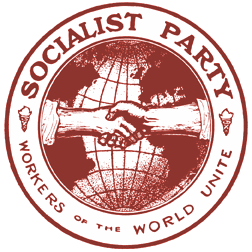Socialist Party of America: Difference between revisions
More languages
More actions
(Using updated parameters (from political_line to political_orientation)) |
(Red Scare) Tag: Visual edit |
||
| Line 14: | Line 14: | ||
=== Split === | === Split === | ||
In May 1912, the Socialist Party held a congress in Indianapolis. The right wing of the party, led by Hillquit, proposed an amendment to the party constitution that banned violence or sabotage against the [[bourgeoisie]]. The amendment was adopted by a vote of 190 to 91. The rightists tried to prevent Eugene Debs from running for president and kicked [[Bill Haywood]] out of the National Committee. In the first four months after the split, party membership dropped from 150,000 to 40,000. The | In May 1912, the Socialist Party held a congress in Indianapolis. The right wing of the party, led by Hillquit, proposed an amendment to the party constitution that banned violence or sabotage against the [[bourgeoisie]]. The amendment was adopted by a vote of 190 to 91. The rightists tried to prevent Eugene Debs from running for president and kicked [[Bill Haywood]] out of the National Committee. In the first four months after the split, party membership dropped from 150,000 to 40,000. The Socialist Party continued to exist for decades after the split, but was highly [[Opportunism|opportunist]]. The left-wing members of the party, including [[C. E. Ruthenberg]], went on to found the [[Communist Party of the United States of America|Communist Party USA]].<ref name=":1" /> | ||
=== Suppression === | |||
During the [[First Red Scare]], members of the [[Ku Klux Klan|KKK]] and [[American Legion]] attacked Socialists. As a result of this repression and defections to the new Communist Party, membership dropped to 12,000 in 1922.<ref name=":0233">{{Citation|author=Albert Szymanski|year=1984|title=Human Rights in the Soviet Union|chapter=The Land of the Free|page=172|pdf=https://cloudflare-ipfs.com/ipfs/bafykbzaceazdmtb2y3qq27fve5ib3gk7uv2unt6ae2xss74xmfpur7k5uhl5m?filename=Albert%20Szymanski%20-%20Human%20Rights%20in%20the%20Soviet%20Union_%20Including%20Comparisons%20with%20the%20U.S.A.-Zed%20Books%20Ltd.%20%281984%29.pdf|city=London|publisher=Zed Books Ltd|isbn=0862320186|lg=https://libgen.rs/book/index.php?md5=C597B1232D9EA6B0F3DCB438D7E15A81}}</ref> | |||
== Criticism == | == Criticism == | ||
Revision as of 20:59, 16 April 2023
Socialist Party of America | |
|---|---|
 | |
| Founders | Eugene Debs Morris Hillquit |
| Founded | July 29, 1901 |
| Dissolved | December 31, 1972 |
| Youth wing | Young People's Socialist League |
| Membership | 150,000 (May 1912) |
| Political orientation | Democratic socialism |
The Socialist Party of America (SPA) was a left-wing political party in the United States. It was founded in 1901 and declined after a split in 1912 between opportunists and the left faction of the party.
History
Foundation
The Socialist Party of America was founded on July 29, 1901 in Indianapolis. 125 delegates were present at the founding convention: 70 from Morris Hillquit's faction of the Socialist Labor Party, 47 from the Social Democratic Party led by Eugene Debs, and eight from other groups.
The second convention of the party, held in May 1904, had 184 delegates from 35 states. By this point, the SPA had over 20,000 members and ran several newspapers in English and other languages.[1]
Peak
In 1908, the party created a national women's commission. By 1912, the Socialist Party had 120,000 members, a tenth of them in the state of Pennsylvania. The Socialist Party had socialists as mayors in 56 towns and cities, including Milwaukee, and Victor Berger was elected as the first socialist congressman. In 1913, the Young People's Socialist League was formed as the youth wing of the party.[2]
Split
In May 1912, the Socialist Party held a congress in Indianapolis. The right wing of the party, led by Hillquit, proposed an amendment to the party constitution that banned violence or sabotage against the bourgeoisie. The amendment was adopted by a vote of 190 to 91. The rightists tried to prevent Eugene Debs from running for president and kicked Bill Haywood out of the National Committee. In the first four months after the split, party membership dropped from 150,000 to 40,000. The Socialist Party continued to exist for decades after the split, but was highly opportunist. The left-wing members of the party, including C. E. Ruthenberg, went on to found the Communist Party USA.[2]
Suppression
During the First Red Scare, members of the KKK and American Legion attacked Socialists. As a result of this repression and defections to the new Communist Party, membership dropped to 12,000 in 1922.[3]
Criticism
The Socialist Party of America had a class reductionist policy towards the African diaspora in the United States. The party's leadership was also infiltrated by the petty bourgeoisie.[1] Lenin and the Second International criticized the party for its racism against Chinese immigrants.[2]
References
- ↑ 1.0 1.1 William Z. Foster (1952). History of the Communist Party of the United States: 'The Socialist Party (1900-1905)'.
- ↑ 2.0 2.1 2.2 William Z. Foster (1952). History of the Communist Party of the United States: 'The Heyday of the Socialist Party (1905-1914)'.
- ↑ Albert Szymanski (1984). Human Rights in the Soviet Union: 'The Land of the Free' (p. 172). [PDF] London: Zed Books Ltd. ISBN 0862320186 [LG]
